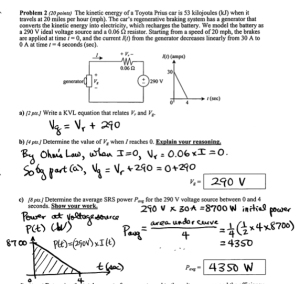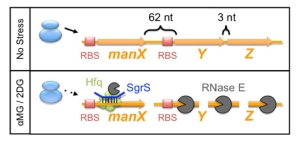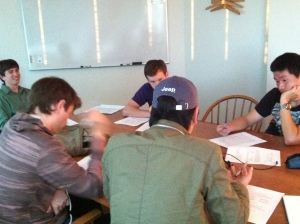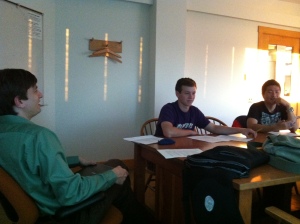by Andrea R. Olinger
“What is visual analysis?” “What kind of point should I be trying to prove in an art history paper?” “What’s the best way to structure a paper that compares two works of art?”
These are the kinds of questions that students taking introductory Art and Design courses have asked Laura Shea, a PhD student in Art and Design and this past year’s “Writing TA.”
UIUC undergraduate and graduate students have always able to make appointments at the Writers Workshop. But recently, two units in the College of Fine and Applied Arts—Art and Design and Urban and Regional Planning—have found new ways to help their undergraduate students learn discipline-specific writing. These units have funded Teaching Assistants to consult with and develop programs for students across a set of courses (Art and Design) or an entire department (Urban and Regional Planning).
Art and Design: Writing TA
For Art and Design, the Writing TA position was created to support the growing number of international undergraduate students who speak English as an additional language (EAL). According to Alan Mette, Executive Associate Director of the School for Art and Design, 15-20% of undergraduate students are international EAL students, a number that has increased in the department over the past five years but has been rising across campus since 2005.*
In 2013-14, Laura worked with students in introductory Art and Design courses like Art History 112 and Art Foundations 105. She would meet students in the Ricker Library of Architecture and Art, which had the added benefit of introducing students to the library who had not yet visited it. Students typically brought in assignments such as comparison papers, visual analyses, research papers, and artist statements. Most students who came, Laura reported, asked questions specific to writing in the discipline: “How do you cite in an art history paper? What kind of point should I be trying to prove?” Other popular questions, she noted, ranged “anywhere from how to make an outline, to how to write a thesis statement, to the kind of language needed to sound formal and professional enough for the assignment.”
In addition to consulting with individual students, Laura collaborated with TAs in the introductory courses, visiting their sections so they could split up and give groups individualized feedback. According to Alan, the School of Art and Design would like to make this a permanent TA position and is currently searching for a Writing TA for 2014-2015.
Urban and Regional Planning: Planners’ Writing Exchange
A few blocks away, the Department of Urban and Regional Planning operates the “Planners’ Writing Exchange” (PWE). Since 2011, the department has funded a graduate student TA to hold individual consultations with undergraduate and graduate students, lead lunchtime workshops, and maintain the PWE website. In 2013-14 the PWE was staffed by Natalie Prochaska, a graduate student in Urban Planning. Natalie said that students brought in a wide variety of texts, including policy memos, literature reviews, white papers, graduate school application essays, and graphically embedded text made in Adobe Illustrator. Inspired by the Writing Across the Curriculum seminar for TAs that she attended in January 2014, Natalie said that she has stressed “identifying and following an individual writing process.” She explained, “When you talk about the writing process as unique to each individual, and then offer some advice for optimization at different stages within that process, students seem more open to that advice and those tools.”
Natalie’s workshops, around three per semester, ranged from topics like the genre of policy memos to issues of grammar. The majority of students who used the PWE’s services this past year were undergraduates, and Natalie estimated that about 60% were EAL students. The students, she remarked, have been “overwhelmingly positive” about the PWE, and they regularly observed how valuable it was to get feedback from someone in their department—an opportunity the Writers Workshop can’t always offer.
Departmental writing TAs can have an even bigger impact when they have access to in-service training on the teaching and learning of disciplinary writing. Both Laura and Natalie, for instance, participated in Center for Writing Studies’ Writing Across the Curriculum seminars for TAs, and the Center also offered a specialized workshop on supporting EAL writers just for Art and Design TAs. (Click here for some resources from that workshop.)
If you’re thinking about using discipline-specific Writing TAs, try to build in opportunities for them to collaborate with other instructors in the department and to provide feedback to the department, especially to the faculty and committees that shape the curriculum. Because of their location, departmental writing TAs collect lots of information about successful and unsuccessful prompts, the range of writing tasks assigned in courses, and variations in instructor expectations. They can, as a result, be invaluable resources for departments wishing to improve how writing is taught, whether in a single course or across a sequence of courses.
We’re always eager to hear about innovations that instructors and academic units are making to better support students’ writing, so please let us know what you’re doing. We may feature you in the fall!
*As of fall 2013, 15.5% of undergraduate students were classified as “international”; you can view UIUC demographic information here. Since 2006, the Institute for International Education has identified UIUC as enrolling the greatest number of international students of all U.S. public universities.




